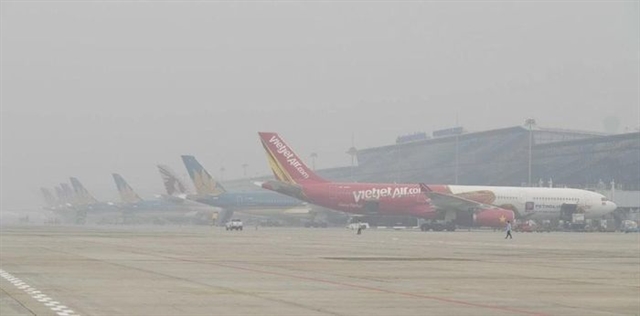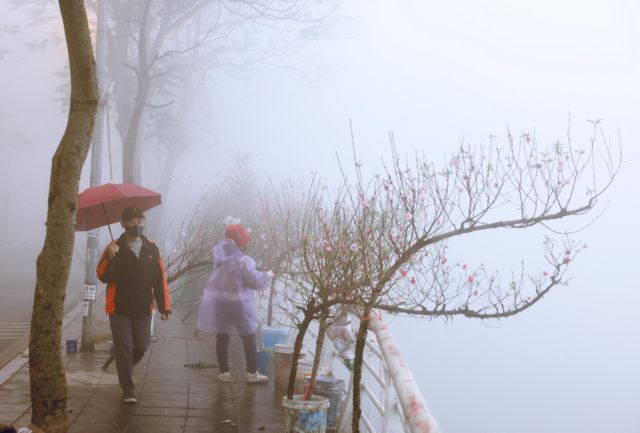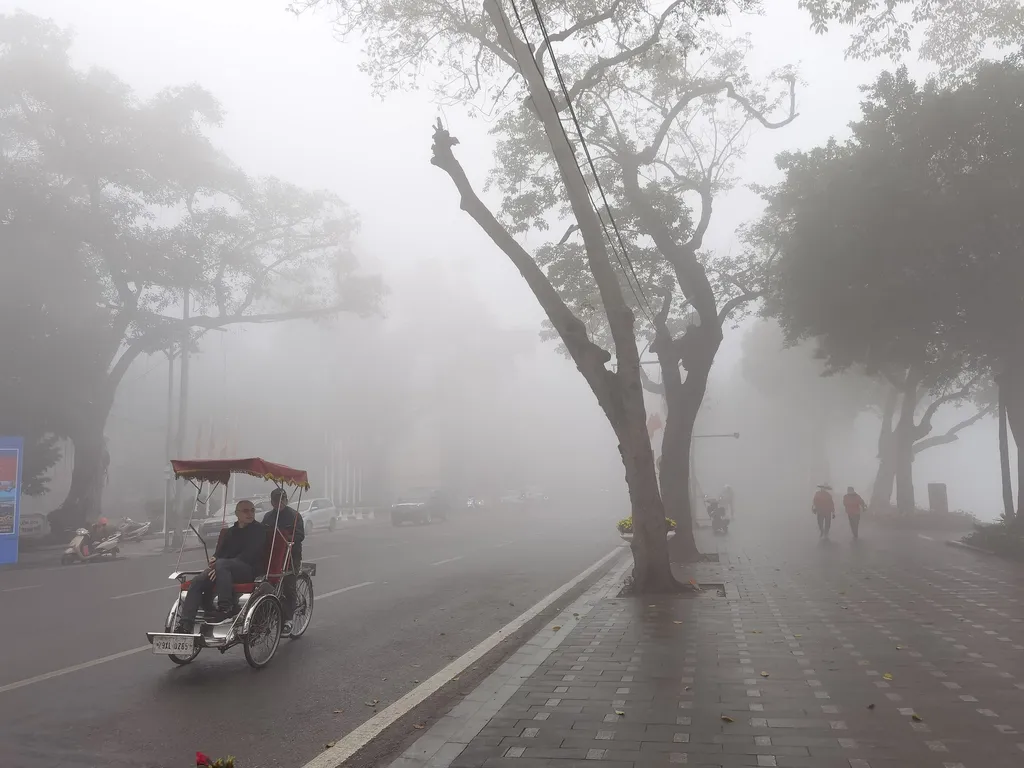 |
| Nội Bài International Airport (NIA) is covered in fog. According to the NIA, the fog and low cloud cover limited visibility for pilots, making it unsafe for aircraft operations. — VNA/VNS Photo |
HÀ NỘI — Flights in Nội Bài International Airport (NIA) in Hà Nội could not take off or land, due to the unusual thick fog cloaking the capital city on Friday.
According to the NIA, from around 2:15am to 9:00am this morning, the thick fog and low cloud cover limited visibility for pilots making it unsafe for aircraft operations. Many flights were affected, forcing Nội Bài International Airport to activate a safety protocol.
To ensure safety, some flights had to divert their landings to other airports or postpone, flying in holding patterns to wait for better weather.
There were about 37 flights unable to land at Nội Bài International Airport, with 12 flights diverted to nearby airports. Also, during this time frame, to ensure flight safety, 54 flights scheduled to depart from Nội Bài had to delay take-off to wait for better weather.
The phenomenon of dense fog typically occurs in Hà Nội and northern provinces of Việt Nam around February and March. Units in the aviation industry are always ready with contingency plans under conditions of limited visibility to ensure safe flight operations.
“Nội Bài International Airport hopes for passengers’ understanding and compliance with the operational instructions of aviation personnel to ensure security and order and flight safety for passengers,” emphasised the airport’s leadership.
Due to the impact of dense fog and bad weather in the areas of Nội Bài Airport (Hà Nội), Thọ Xuân Airport (Thanh Hóa), Vinh Airport (Nghệ An), and Phú Bài Airport (Huế), to ensure safe operations, Vietnam Airlines had to adjust the departure times, delaying from two to six hours for flights to and from these airports in the early morning and on Friday.
Specifically, the affected flights include 8 flights from Hồ Chí Minh City to Vinh with flight numbers VN7000, VN7004, VN7006, VN7008, VN7012, VN7014, VN7016, and VN7264. Flight VN7278 from Hồ Chí Minh City to Thanh Hóa, VN7540 from Hồ Chí Minh City to Huế also experienced delayed departure times.
At Nội Bài Airport, many domestic and international flights landing here had to circle or land at alternative airports in Hải Phòng or Đà Nẵng, waiting for better weather conditions to meet operational requirements. Departing flights from Nội Bài also had to delay their operational times to ensure safety.
“Nearly 30 other domestic and international flights were affected in the queue, changing their schedules,” said a representative of Vietnam Airlines.
Earlier on the night and early morning of Thursday, also due to the impact of dense fog at Thọ Xuân and Vinh airports, four flights from Hồ Chí Minh City to these locations were also delayed, from one to nearly five hours.
“Rainy and foggy weather conditions may occur at airports in the northern and central regions in the coming days. Passengers with travel needs to provinces and cities in the northern region during this period should regularly monitor schedule information and weather conditions,” advised Vietnam Airlines.
 |
| Fog in Trích Sài near West Lake. People commuting on Friday morning also face difficulties, as the fog restricted visibility. — VNA/VNS Photo Lâm Khánh |
Fog hinders daily life
The fog in Hà Nội also accompanied bad PM2.5 levels throughout the city. Central districts such as Đống Đa and Ba Đình registered figures of around 260, while suburbs such as Nam Từ Liêm and Cầu Giấy are around 230, all of which are at “very unhealthy” levels.
People commuting on Friday morning also faced difficulties, as the strange fog restricted vision.
In winter, Hà Nội and the northern provinces experience reduced ground heat from the sun, causing rapid cooling of the ground during the night and early morning. This cooling phenomenon leads to temperature inversion, where the air near the ground becomes colder than the air above, creating stable stratification that restricts the upward movement of heavier air.
Fog occurs when water vapour condenses into tiny droplets in the air near the ground, reducing horizontal visibility to less than 1km. Typically appearing white, fog can sometimes have a yellow or greyish colour. It often occurs in early morning or late afternoon during winter, and traps smoke, dust and pollutants in the air.
The Environmental Health Management Department (Ministry of Health) has issued guidance to Provincial Departments of Health and Central Subordinate Cities on health protection measures against the impact of air pollution. When the air quality index is very poor (201 – 300), ordinary individuals are advised to limit outdoor activities, exercise caution during physical activities, and favour indoor activities.
Avoiding high air pollution risk areas is recommended, and if necessary, using masks to prevent fine dust exposure. Public transportation is encouraged over motorcycles or bicycles, and opening windows and doors should be limited during periods of heavy air pollution. Rinsing the nose, throat and eyes with saline can help ease irritation.
Sensitive individuals are recommended to completely avoid outdoor activities during heavy air pollution periods. If leaving the house is necessary, minimise time spent outdoors and use masks that prevent fine dust exposure. If acute symptoms such as difficulty breathing, coughing, or fever arise, seeking immediate medical attention for examination, consultation and treatment. — VNS
 |
| Hoàn Kiếm Lake area in the heart of Hà Nội. — VNA/VNS Photo Thanh Tùng |
- Reduce Hair Loss with PURA D’OR Gold Label Shampoo
- Castor Oil Has Made a “Huge” Difference With Hair and Brow Growth
- Excessive hair loss in men: Signs of illness that cannot be subjective
- Dịch Vụ SEO Website ở Los Angeles, CA: đưa trang web doanh nghiệp bạn lên top Google
- Nails Salon Sierra Madre
 VnExpress News The News Gateway of Vietnam
VnExpress News The News Gateway of Vietnam





